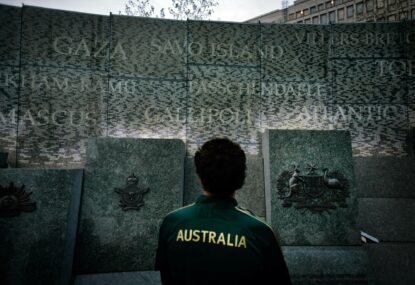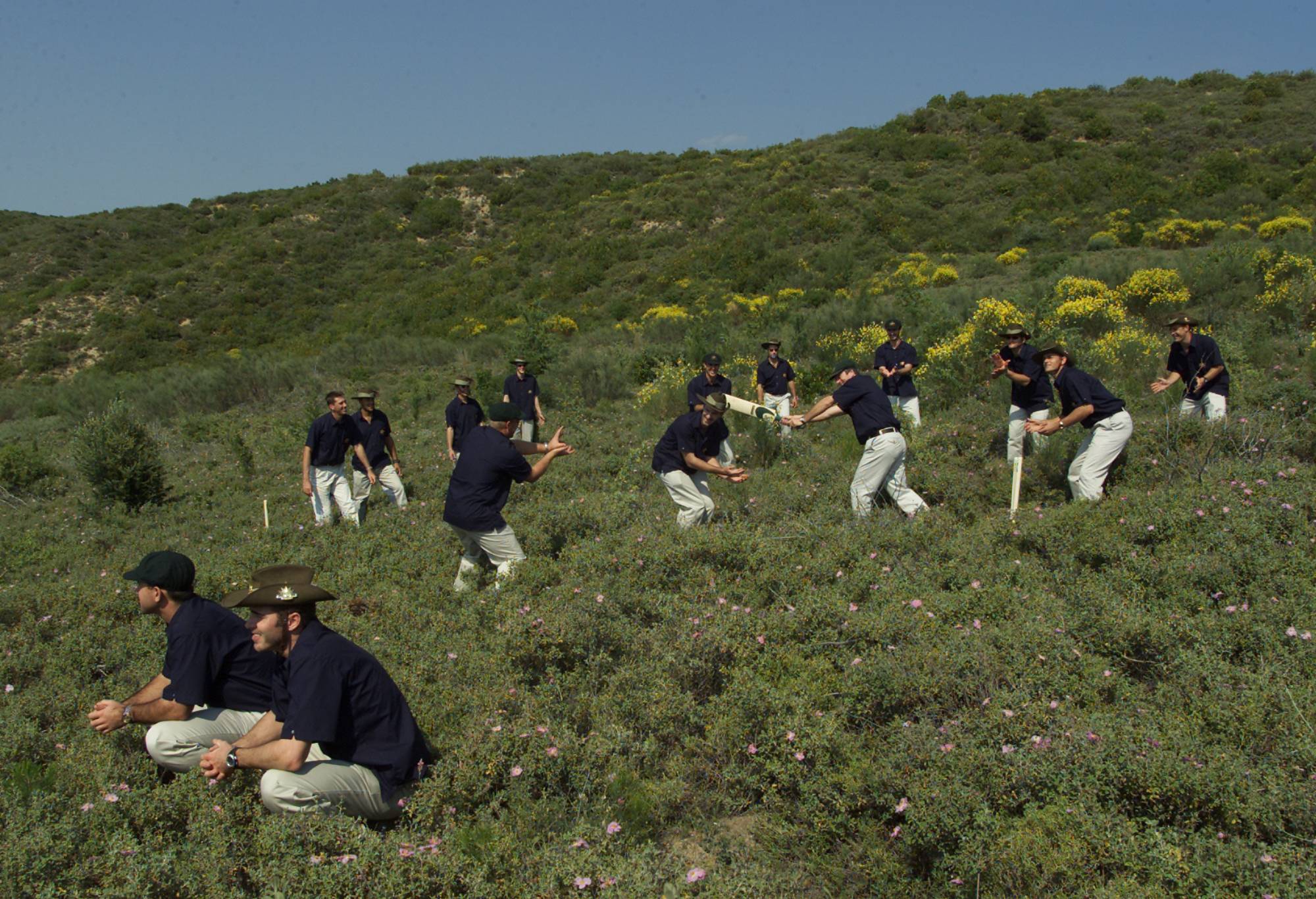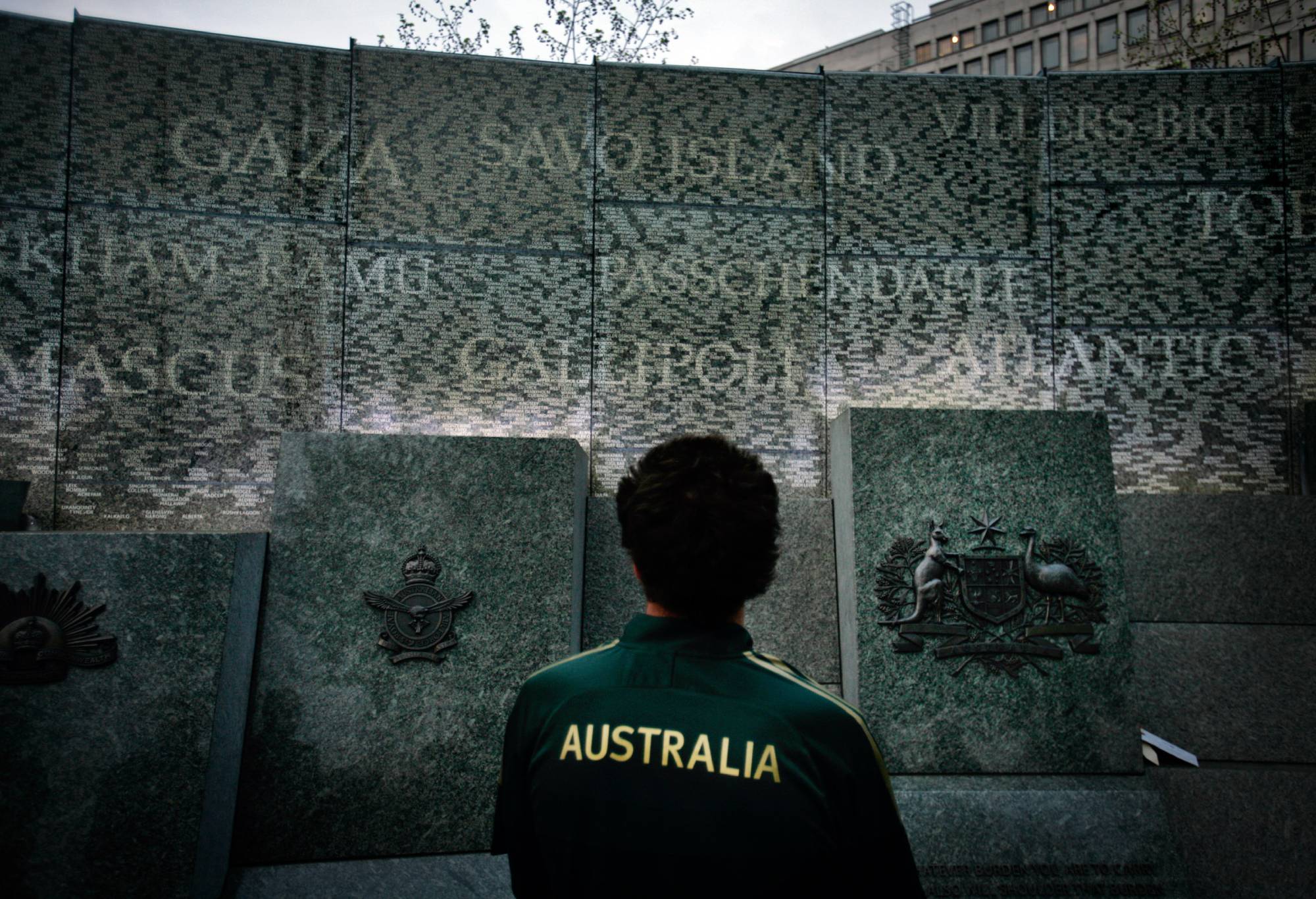Lionheart
new author
Roar Rookie

Anzac Day marks the anniversary of the landing of the Australian and New Zealand Army Corps at Gallipoli in Turkey on 25 April 1915. It’s our day to commemorate and remember our war dead, and all who have served our country in war and peace.
Sport is a part of Service life but rarely is it part of an operational plan. At Gallipoli, the ANZACs played a game of cricket to help hide their withdrawal. They played on Shell Green which was subject to artillery fire and is now a war graves cemetery.
The match is evidence that cricket was played at times at Gallipoli. Football (soccer) was played too, maybe as therapy as a photo of some medical staff and others in slouch hats kicking a round-ball with trenches and an exploding shell in the distance suggests.

The 2001 Australian cricket team re-enact a famous photograph at Shell Green, Gallipoli, Turkey. The famous photograph was taken while Australian soldiers played a game of cricket on the same location, in an attempt to create a diversion to the Turkish Soldiers, on December 17th 1915. (Photo: Hamish Blair/ALLSPORT)
ANZACs played Rugby Union and soccer against British units both in Egypt and on the Greek island of Imbros after Gallipoli. In England by 1917, teams were playing on average four games per month in the YMCA league while Australian Rules football was played between AIF units in Egypt and in England, where a demonstration match was played in London in October 1916.
Six VFL players died on the first day at Gallipoli, 25 April 1915 although only one of them, Arthur (Joe) Pearce who was killed before he stepped ashore, has a known grave. Two of the five Wallabies players who died at Gallipoli were killed on the first day including Ted Larkin, an MP and Secretary of the NSW Rugby League.
Harold George was wounded at Gallipoli and evacuated but died at sea in May 1915.
Clarence Wallach, also a Wallaby and one of six brothers from Bondi who served in World War One, arrived at Gallipoli in August.
In France, he successfully led a night trench raid in July 1917 and was awarded the Military Cross in September for his actions in fighting around Poziers. He suffered gunshot wounds to both legs in April 1918 and died a few days later, nine days before his younger brother Neville.
Five of the 1908 Kangaroos Rugby League tour served in the British Army in WW1 and seem to have survived. Steve Darmody lost a leg in Flanders, was discharged and reenlisted after he got an artificial leg. Joe Murray, a Balmain player and 1911-12 Kangaroo, enlisted as a Sapper in September 1915 and served in France and Belgium. He was awarded the Distinguished Conduct Medal in July 1917 and played just one more season post war, for North Sydney.
Bert Chadwick a VFL player, claimed that the sand ovals in Palestine helped build the strength in his game. He served in the Flying Corps and played regular Australian rules matches against the Light Horse regiments. They entered a team in the Palestine National Games in 1940, athletics, boxing and swimming.
Their first international sporting event was a soccer match against the high-flying first division club, Rishon Maccabi in April 1940 in front of a large and vocal crowd. Bands played and they marched to after-match celebration.
William (Billy) Orchard, who played VFL for Geelong, suffered a shrapnel wound to the head from an accidental grenade and later a bayonet wound to the leg. He was unable to play post war and became a VFL umpire.

A Rugby world cup of sorts was played in England at the end of World War One, when the Armies of Great Britain, Canada, South Africa, New Zealand, Australia and the Royal Air Force played for The King’s Cup. New Zealand won the tournament, but Australia beat them in a qualifying game.
Weary Dunlop was a fine all-round sportsman and the first Victoria-born Wallaby. He was a Doctor in the Medical Corps in the Middle East, Greece and Crete before he was captured in Java in March 1942.
He commanded a work battalion on the Thai-Burma railway and inspired his men with his medical care under very rudimentary conditions, and as a commander in the face of horrific depravity and frequent brutal treatment.
Contact sports were banned for the POWs after the Thai-Burma railway, because of their frailty and the high risk of injury. Winston (Blow) Ide, a 1939 Wallaby whose Australian father was interned because he was born in Japan, was captured in Singapore in February 1942.
He survived the Thai-Burma railway, but he died at sea in September 1944 when the Japanese transport ship transferring him to work in Japan was sunk by Allied submarine.
Andrew (Nicky) Barr, whose painted portrait is on display at the Australian War Memorial, Canberra was a Victorian schoolboy champion runner and played Australian Rules football until age 20 before he switched to rugby. New Zealand born, he was selected for the 1939 Wallaby tour.
He shot down 12 enemy aircraft as a fighter pilot in North Africa, and damaged eight more. He was shot down himself three times, evading capture twice but not a third, in June 1942.
Nicky escaped from POW camps four times before he eventually reached safety in March 1944, in time to fly again to support the Normandy landings.
Dan Quinn of Wollongong, a former international football player and long-distance runner was known as the fastest referee in the NSW State League in the 1930s. He served in Malaya and was captured in Singapore. He died of malnutrition and dysentery in Japan in November 1943.
Brothers James, John and Joe Peebles were soccer players who joined the AIF in World War One. John stated his occupation as sStriker’ on his paperwork. He and James, both Brisbane representative players, played for AIF teams in Australia before they moved to France. Joe also served in France and suffered trench fever but survived the war.
James Peebles was killed in action in Belgium in June 1917. John survived and played again in Brisbane in the 1920s, captained Queensland and played for Australia in 1923.
Albert (Tibby) Cotter was a Test cricketer described by some as Australia’s best fast bowler of the early twentieth century. ‘Terror Cotter’ to England fans, he served in the Light Horse Brigade in Palestine and was killed in the charge on Beersheba on 31 October 1917.
Charles Backman of Adelaide is the only known Australian first-class cricketer to have lost his life on the first day of the Gallipoli landing. Bert Oldfield, Australian wicket keeper 1920 to 1937 was wounded in action twice in France and Belgium and toured with the AIF cricket team in 1919.
Alex Barras played cricket for WA in 1938-39. His bomber aircraft crashed over enemy held territory near Tobruk (Libya) in July 1942. He led three of his crew for 22 days across the desert, evading capture, sometimes under fire, and survived on minimal water and food.
Many other sportsmen and women have served their country in war and in peace.
It’s appropriate for sports fans to remember them on Anzac Day and commemorate all of our servicemen and women who have served their country, in war and in peace.
Lest We Forget
Graham O’Brien is a veteran of 35 years permanent service. He comments on The Roar as Lionheart.